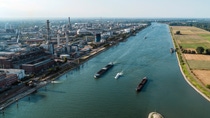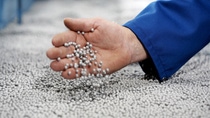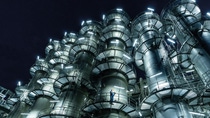Ludwigshafen
World champion in efficiency
The Ludwigshafen site is the cradle of the Verbund idea. It was here that the idea was conceived and continuously further developed. The Verbund helps BASF to handle resources more efficiently and generate competitive advantages.
Of all six BASF Verbund sites, Ludwigshafen is the oldest and largest. Production facilities, energy flow, logistics and infrastructure are networked together intelligently in the Verbund. In this system, chemical processes can run in a resource-efficient way with lower energy consumption and higher yields.
The two steamcrackers, the synthesis gas plant and the acrylic acid works are core elements of the Verbund. They are the beginning of innumerable value chains and their products are further processed into thousands of commercial products through further process steps. Nothing is wasted in the process: The by-products of one facility serve another as a valuable input material.
This creates efficient value chains in Ludwigshafen, from basic chemicals to highly refined products such as paints and pesticides. At the same time, the system helps to save on raw materials and energy, minimize emissions, reduce logistics costs and exploit synergies.
From Ludwigshafen to the world
BASF has exported the Verbund principle of Ludwigshafen to the world: BASF’s second-largest Verbund site is in Antwerp, Belgium. In North America, both sites in Geismar/Louisiana and Freeport/Texas, supported by the steamcracker in Port Arthur/Texas, operate on the Verbund principle. In the Asia-Pacific region, BASF operates both Verbund sites in Kuantan/Malaysia and Nanjing/China.

![Eine Fläche von rund 64.000 Quadratmetern - das entspricht 13 Fußballfeldern - umfasst der Steamcracker II, die größte einzelne Anlage am Standort Ludwigshafen der BASF. Der Cracker ist auch das "Herzstück" der Verbundproduktion. Seit 1981 ist dieser Gigant in Betrieb und spaltet unter Zusatz von Wasserdampf bei etwa 850 Grad Celsius Rohbenzin auf. Dabei entstehen im wesentlichen Ethylen und Propylen, beides unverzichtbare Grundstoffe für die Herstellung vieler Produkte in Ludwigshafen. Abdruck honorarfrei. Copyright by BASF. Steam cracker II, the largest individual plant at BASF's Ludwigshafen site, covers a surface area of about 64,000 square meters, which is about the size of 13 soccer fields. The steam cracker is also the heart of BASF's Verbund production strategy. This giant plant has been operating since 1981 and uses steam to crack naphtha at about 850°C [1,562°F]. This process leads primarily to ethylene and propylene, both indispensable feedstocks for manufacturing numerous products in Ludwigshafen.Print free of charge. Copyright by BASF. Eine Fläche von rund 64.000 Quadratmetern - das entspricht 13 Fußballfeldern - umfasst der Steamcracker II, die größte einzelne Anlage am Standort Ludwigshafen der BASF. Der Cracker ist auch das "Herzstück" der Verbundproduktion. Seit 1981 ist dieser Gigant in Betrieb und spaltet unter Zusatz von Wasserdampf bei etwa 850 Grad Celsius Rohbenzin auf. Dabei entstehen im wesentlichen Ethylen und Propylen, beides unverzichtbare Grundstoffe für die Herstellung vieler Produkte in Ludwigshafen. Abdruck honorarfrei. Copyright by BASF. Steam cracker II, the largest individual plant at BASF's Ludwigshafen site, covers a surface area of about 64,000 square meters, which is about the size of 13 soccer fields. The steam cracker is also the heart of BASF's Verbund production strategy. This giant plant has been operating since 1981 and uses steam to crack naphtha at about 850°C [1,562°F]. This process leads primarily to ethylene and propylene, both indispensable feedstocks for manufacturing numerous products in Ludwigshafen.Print free of charge. Copyright by BASF.](/api/imaging/focalarea/16x9/210x/dam/jcr%3A87aa4a34-64b7-3465-a0b3-ef3e33960cd9/steamcracker.jpg)

